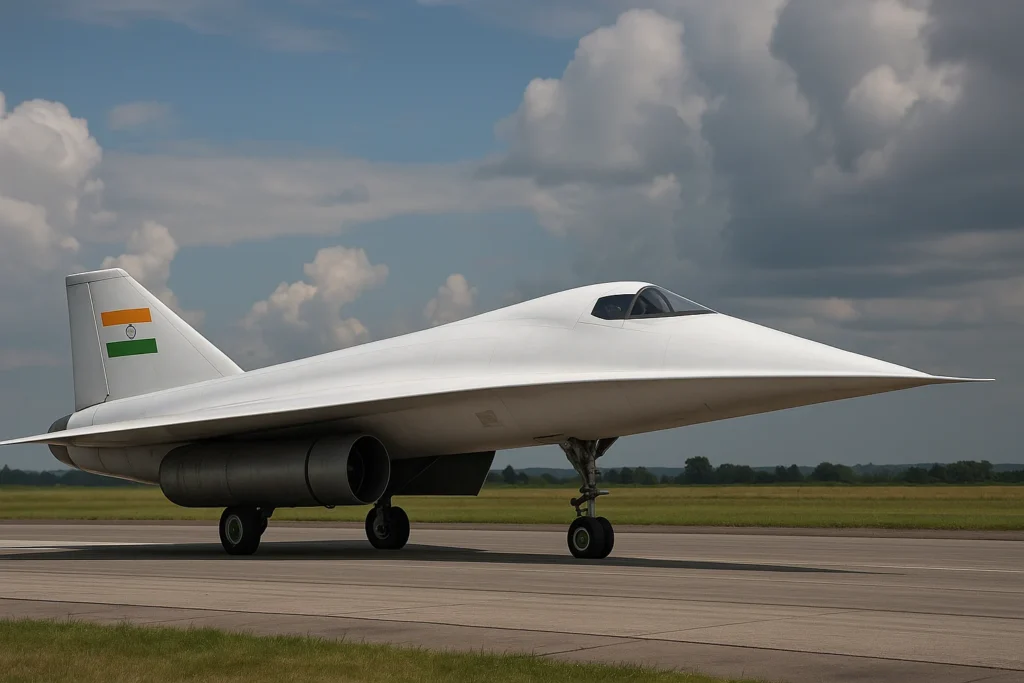For decades, the idea of traveling at speeds five times faster than sound – or even beyond – belonged to the realm of science fiction. Aircraft that could cross continents in a couple of hours, or missiles that could strike targets with almost no warning, seemed like futuristic fantasies. Yet, in laboratories and test facilities across the globe, this very future is being meticulously engineered, pushing the boundaries of physics and aerospace technology. Now, India has firmly established its place in this exclusive club, announcing successful and significant strides in its hypersonic flight program, signaling a new era for its national innovation and strategic capabilities.
This isn’t just about speed; it’s about a complete re-imagining of flight. Imagine a vehicle so fast that friction with the air generates temperatures hotter than molten lava, or an engine that breathes air at supersonic speeds to propel itself forward. These are the incredible challenges of hypersonic flight, and India’s recent breakthroughs demonstrate a mastery of these complex sciences, setting the stage for truly transformative aerospace advancements. From foundational demonstrators to the launch of advanced missiles, India’s hypersonic dream is rapidly taking off.
What Exactly is Hypersonic Flight? Understanding the “Mach 5” Mark
To truly grasp the significance of India’s achievement, it’s crucial to understand what makes “hypersonic” so special. The speed of sound is known as Mach 1. When an object travels faster than sound, it creates a sonic boom.
- Supersonic Flight: This is anything above Mach 1, typically up to Mach 5. Many military jets, like fighter aircraft, are capable of supersonic speeds.
- Hypersonic Flight: This is defined as speeds of Mach 5 (approximately 6,174 kilometers per hour or 3,837 miles per hour) and beyond. At these speeds, the physics of flight change dramatically, posing immense challenges for engineers and scientists.
The Immense Challenges of Hypersonic Speeds:
- Extreme Heat: At Mach 5+, air friction generates incredible heat, capable of melting conventional materials. Designing structures and engines that can withstand thousands of degrees Celsius is a monumental task. This requires advanced thermal management systems and super-strong, heat-resistant materials.
- Aerodynamics: How air flows around a vehicle at hypersonic speeds is vastly different from subsonic or supersonic flight. Designing shapes that remain stable and controllable is incredibly complex.
- Propulsion: The Scramjet Engine: Conventional jet engines can’t operate efficiently at hypersonic speeds because they can’t compress air fast enough without it breaking down. This is where the “scramjet” comes in. A scramjet (Supersonic Combustion Ramjet) is an air-breathing engine that forces incoming air to compress at supersonic speeds, then mixes it with fuel and ignites it, all while the air is still moving faster than sound. It’s like trying to light a match in a hurricane – incredibly difficult to achieve and sustain stable combustion.
- Navigation and Control: Guiding a vehicle that moves at Mach 5 or more, especially one that can maneuver, requires extremely precise navigation and control systems that can withstand the harsh environment.
Mastering these challenges is what places a nation in the “elite global club” of hypersonic technology.
The Journey Begins: India’s Hypersonic Technology Demonstrator Vehicle (HSTDV)
India’s ambition in the hypersonic realm is not new; it’s the culmination of years, even decades, of dedicated research and development by organizations like the Defence Research and Development Organisation (DRDO) and the Indian Space Research Organisation (ISRO). The public’s first major glimpse into this journey came with the Hypersonic Technology Demonstrator Vehicle (HSTDV) program.
The HSTDV was precisely what its name suggests: a testbed, a prototype vehicle designed to prove that India could build and control a vehicle operating at hypersonic speeds, powered by a scramjet engine. This crucial stepping stone aimed to validate several core technologies necessary for future hypersonic systems.
In September 2020, India achieved a landmark success with the flight test of the HSTDV. The vehicle was launched on a rocket booster, which propelled it to an altitude of about 30 kilometers and accelerated it to Mach 6. Once at the desired speed and altitude, the HSTDV separated from its booster, and its indigenously developed scramjet engine ignited. The vehicle then sustained hypersonic flight for over 20 seconds, successfully demonstrating crucial elements like:
- Scramjet Engine Ignition and Sustained Combustion: Proving that India could achieve the incredibly difficult task of stable supersonic combustion.
- Aerodynamic Configuration: Validating the design necessary for maneuvering at such extreme speeds.
- High-Temperature Materials: Showing the capability to manage and withstand the intense heat generated during hypersonic flight.
The HSTDV test was a foundational success, laying the critical groundwork and proving the scientific and engineering prowess required for India to pursue more advanced hypersonic projects. It was a clear signal that India was serious about becoming a major player in this strategic domain.
Breaking Barriers: Scramjet Engine Milestones of 2025
While the HSTDV proved the concept, the real challenge for sustained hypersonic flight lies in the engine’s ability to operate for extended periods. This is where India’s more recent achievements in 2025 mark a significant leap forward, pushing the boundaries of what has been publicly demonstrated globally.
The Defence Research & Development Laboratory (DRDL), a key part of DRDO based in Hyderabad, has been at the forefront of this effort, focusing on perfecting the scramjet combustor – the heart of the engine where supersonic combustion takes place.
- January 2025: The 120-Second Test: DRDL announced a successful ground test of an active-cooled scramjet subscale combustor for 120 seconds. This demonstrated a considerable improvement in sustaining the extreme conditions required for hypersonic propulsion.
- April 2025: The Game-Changing 1,000-Second Test: Just a few months later, on April 25, 2025, DRDL announced a monumental achievement: a 1,000-second (over 16 minutes) ground test of the same active-cooled scramjet subscale combustor. This was conducted at a newly built, state-of-the-art Scramjet Connect Test Facility in Hyderabad.
Why is 1,000 seconds so significant?
Sustaining stable supersonic combustion for such an extended duration is an incredibly difficult engineering feat. It validates the design of the long-duration scramjet combustor, the efficiency of its active cooling system (which prevents the engine from melting), and the capabilities of the testing facility itself. This prolonged operation moves India much closer to developing true hypersonic cruise missiles capable of sustained flight over long distances, unlike boost-glide vehicles that primarily glide after being launched by a rocket. This achievement is a critical step towards integrating a flight-worthy engine into a functional hypersonic system.
Project Vishnu: India’s First Hypersonic Missile Takes Flight
Building on the foundation laid by the HSTDV and the breakthroughs in scramjet engine technology, India has swiftly moved towards developing operational hypersonic systems. The culmination of these efforts was seen in late 2024 with a discreet yet profoundly impactful flight test.
In November 2024, India successfully conducted the flight test of a Long-Range Hypersonic Missile (LR-HM), a project reportedly operating under the codename “Project Vishnu.” This weapon system, also referred to as the Extended Trajectory-Long Duration Hypersonic Cruise Missile (ET-LDHCM), represents a significant indigenous advancement in India’s strategic arsenal.
Key capabilities of the ET-LDHCM, as reported, are truly impressive:
- Speed: Capable of flying at speeds of up to Mach 8 (approximately 9,800 km/h or 6,100 mph), making it nearly three times faster than India’s current supersonic BrahMos missile.
- Range: An estimated operational range of 1,500 kilometers (930 miles), allowing for deep strikes far beyond traditional capabilities.
- Propulsion: Powered by an advanced air-breathing scramjet engine, confirming the successful application of the technology demonstrated in the ground tests. This air-breathing capability allows it to use atmospheric oxygen, making it lighter and faster than traditional rocket-powered missiles that carry their own oxidizer.
- Stealth and Maneuverability: Designed with an altitude-hugging flight profile and the ability to perform complex mid-course corrections and unpredictable flight trajectories. This makes it incredibly difficult, if not impossible, for existing air defense systems to intercept.
- Versatility: Capable of carrying both conventional and nuclear warheads and designed for launch from land, air, and sea platforms, offering significant strategic flexibility.
The successful flight of the ET-LDHCM is a game-changer. It means India has not only mastered the complex science of hypersonic flight but has also translated that knowledge into a tangible, strategic weapon system.
Joining the Elite Global Club: A Strategic Imperative
With these continuous advancements, particularly the successful flight test of the ET-LDHCM and the 1,000-second scramjet combustor demonstration, India has undeniably joined an elite and very small club of nations possessing advanced indigenous hypersonic capabilities. This group currently includes:
- United States: Has multiple ongoing programs for both hypersonic cruise missiles and glide vehicles.
- Russia: Has publicly fielded and claimed to use several hypersonic missile systems.
- China: Has rapidly advanced its hypersonic capabilities, demonstrating a range of systems.
India’s entry into this club is not merely a matter of prestige; it carries profound strategic implications:
- Enhanced Deterrence: The possession of hypersonic missiles significantly strengthens India’s deterrence posture. Their speed and maneuverability make them extremely difficult to intercept, presenting a formidable challenge to any adversary’s air defense systems. This reduces response times and enhances the credibility of India’s retaliatory capabilities.
- Self-Reliance (Atmanirbhar Bharat): These achievements underscore India’s growing indigenous technological prowess in cutting-edge defense technologies. It reduces reliance on foreign suppliers for critical military hardware and boosts the “Make in India” initiative within the defense sector.
- Regional Power Dynamics: In a rapidly evolving geopolitical landscape, particularly in the Indo-Pacific region, hypersonic capabilities provide India with a significant strategic advantage, allowing it to project power and safeguard its interests more effectively.
- Foundation for Future Technologies: The research and engineering breakthroughs in hypersonic flight also have spillover benefits for other high-tech sectors, including advanced materials, propulsion systems, and aerospace manufacturing, potentially opening doors for future civilian applications.
This progression marks India’s transformation from a nation with hypersonic ambitions to one with demonstrated, high-impact capabilities.
Beyond Missiles: The Broader Promise of Hypersonic Flight
While the immediate application of India’s hypersonic breakthroughs is undoubtedly in the defense sector, the underlying technologies have a far broader potential. The mastery of scramjet propulsion, extreme temperature materials, and advanced aerodynamics is foundational for a range of future applications beyond just weaponry.
Imagine:
- Ultra-Fast Global Travel: Hypersonic passenger aircraft that could take you from Delhi to New York in just a few hours. While still a distant vision, the engine and material science breakthroughs being made for missiles are direct precursors to such future aerospace vehicles.
- Rapid Space Access: Hypersonic “aircraft” could potentially serve as reusable first stages for launching satellites into orbit, significantly reducing the cost and increasing the flexibility of space access. This aligns with ISRO’s long-term vision for reusable launch vehicle technologies.
- Advanced Reconnaissance: Uncrewed hypersonic vehicles could perform surveillance missions with unprecedented speed and reach, providing critical intelligence gathering capabilities that are virtually impossible to intercept.
- Emergency Response: Future hypersonic platforms could potentially be used for extremely rapid deployment of aid or specialized personnel to remote disaster zones.
For now, the focus remains on the strategic imperative of defense. However, the scientific and engineering talent being nurtured, and the technological base being established, mean that India is not just building faster missiles; it’s building the very building blocks for a future where the sky is no longer the limit for speed and reach.
The Road Ahead: Challenges and India’s Aspirations
Despite these monumental successes, the journey into the full operationalization and broader application of hypersonic technology is still evolving. Significant challenges remain on the path to widespread deployment:
- Cost and Scalability: Hypersonic systems are incredibly complex and expensive to develop and produce. Scaling up production for large-scale induction will require substantial investment and industrial capacity.
- Materials Science: While progress has been made, developing new materials that can withstand sustained hypersonic speeds and repeated use remains a critical area of research.
- Integration and Interoperability: Integrating these new advanced weapon systems seamlessly into existing defense architectures and ensuring their interoperability with other platforms is a complex task.
- Testing and Validation: Extensive flight testing under various real-world conditions will be necessary to fully validate the reliability and performance of these systems before full operational deployment.
DRDO officials have indicated that while the hypersonic glide vehicle program is at an advanced stage with potential induction in 2-3 years, a full-scale hypersonic cruise missile system, leveraging the recent scramjet engine breakthroughs, might still take another 5-7 years to reach operational status, pending government approval for a dedicated program.
Yet, India’s trajectory is clear. The successful ground tests of its scramjet engine and the flight test of its long-range hypersonic missile demonstrate a national resolve to master this cutting-edge domain. These achievements not only bolster India’s defense capabilities but also position the nation as a formidable innovator in global aerospace. The dream of Mach 5 and beyond is no longer a distant whisper; it’s a powerful roar from India, echoing across the skies.



